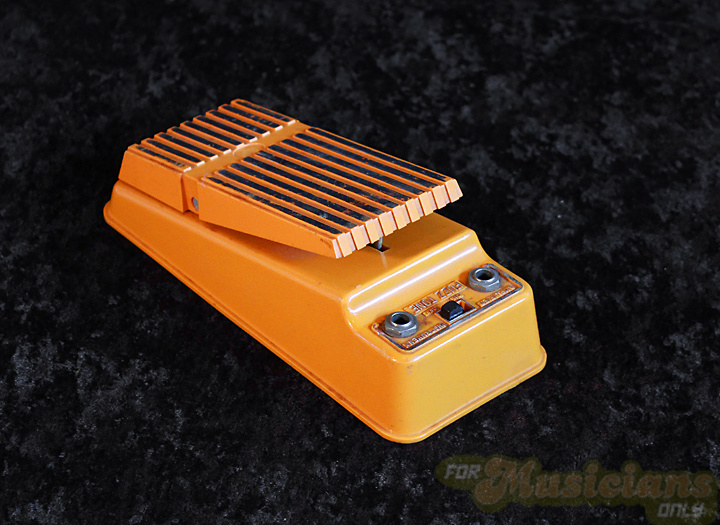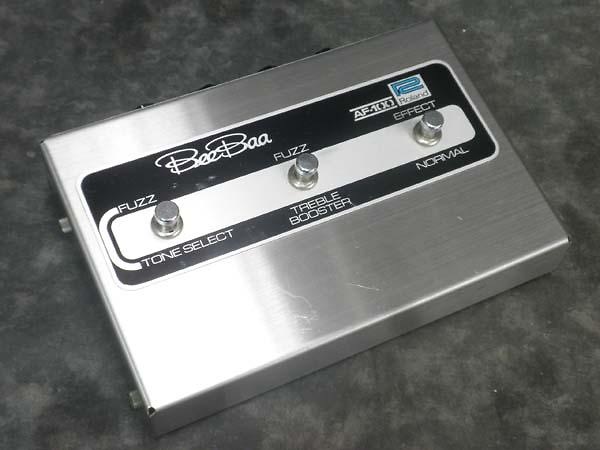I'm not old enough to remember the "germanium age" of the '60s, but as Tone Report's self-appointed pedal historian, I'm well aware of its breadth. Since man first fuzzed, the Western world used dump trucks full of germanium components to satisfy fuzz lovers everywhere. From the original Maestro Fuzz Tone's RCA-branded 2n270 to the Newmarket NKT275 of the Dallas-Arbiter Fuzz Face, players wanted that smooth sustaining fuzz, and manufacturers were happy to oblige. Germanium fever swept across the world—most of it.
When germanium devices were eschewed in favor of silicon devices, the Western fuzz market became one-sided. Dallas-Arbiter transitioned to a silicon-equipped Fuzz Face, while Colorsound crafted its One Knob Fuzz, which was (surprise!) also a Fuzz Face. The Big Muff also made its entrance around this time, but apart from these and a few fringe builders, this was the fuzz landscape. In Japan, however, silicon fever was just getting started, and this era saw a group of highly innovative and influential fuzzboxes make its way from the Far East. Here are eight of them.
Ace Tone Fuzz Master FM-2

The third entry in the Ace Tone line, the FM-3, is nothing more than a Big Muff clone with a clumsy boost circuit in front. Guitarists of this era could just as easily use the excellent Electro-Harmonix LPB-1 in front of their Big Muffs, so the execution was lukewarm at best. However, before this blatant copy, Ace Tone had a very original circuit on its hands. In what would become a running theme in Japanese fuzzes, the FM-2 utilizes a transistor differential pair to generate octave-up overtones throughout pure, unbridled fuzz madness. A Tone switch is mounted on the face that selects between two separate sounds, and both are uniquely over the top. Players looking for this sound need not seek out an original, as the excellent EarthQuaker Devices Fuzz Master General and Verellen Big Spider are based on this circuit and much more readily available.
Ibanez Standard Fuzz
A subsidiary of the Hoshino Gakki group of Japan, Ibanez got its start importing Spanish guitars in the early 1900s, hence the name. And before the murky Ibanez-Maxon kinship, Ibanez made quite a few pedals, including the Ibanez Standard Fuzz. This pedal is far from "standard," however, and topologically, is basically a darker version of the Ace Tone FM-2 with a then-unheard-of FET preamp. Tonally and aesthetically, the two are quite different beasts, and the Standard has the distinction of being sold under many different brand names. The Standard pairs exceptionally well with single coils and the standard array of trashy pickups found on Japanese guitars of the era, as they offset the murkiness just enough to be useful. Humbucker players need not apply. This pedal also loves to be fed into other pedals; by itself, it gets an A for effort.
Univox Super Fuzz
The most well-known Japanese fuzz is the Univox Super Fuzz, for two reasons. One: Univox was actually started in America (as Unicord) and then moved to Japan to cut costs, thereby keeping a foothold in Western markets in which to distribute. Two: Pete Townshend used one. The Super Fuzz circuit is somewhat close to the FM-2 but the differential pair shows up at the end of a series of gain stages. Essentially, this arrangement is akin to running an octave-up fuzz after a gnarly fuzz instead of the other way around, resulting in a buzzsaw-like fuzz that still sings when used correctly. If that's not enough, the enclosure looks certifiably bad-ass; the majority of its surface area is comprised of a giant rubber mat that says “SUPER-FUZZ” in no uncertain terms.
Honey Special Fuzz

Let us hop into our Wayback machine and visit a time before Shin-Ei, original Japanese designer of the Super Fuzz, was Shin-Ei, and was known as Honey. As Honey, the company released several pedals that were subsequently cloned end-on-end through various manufacturers. One of Honey’s two fuzz boxes (the other being the Baby Crying, identical to a Super Fuzz, and the Psychedelic Machine doesn’t count) was the Special Fuzz and it also holds the distinction of being the only Honey pedal that wasn’t thrown to the rebranding wolves. Be that as it may, it’s actually a super-complicated circuit containing two wah inductors. These inductors are used when the fuzz’s “Special” switch is activated, which turns the pedal into some type of strange fuzz-filter hybrid. It’s a truly special sound for a truly special device.
Kay Fuzz Tone

Some older players might remember the Kay pedals as plastic treadle boxes, usually containing a circuit not normally controlled by such an apparatus. Some other players might remember Kay as a manufacturer of stringed instruments in the earlier part of the 20th century. Both camps are correct, though in name only. In 1969, the Kay brand was sold off, piece by piece. A Teisco importer bought the Kay guitar division, and these Kay pedals were subsequently made overseas. The orange Fuzztone’s claim to fame is usage by some guy named David Evans from some band called U2. The Fuzztone is again, similar to the Super Fuzz but still, different. Two of the Super Fuzz’s gain stages are missing from the Kay, including one crucial one that follows the differential pair. The result is a much more clearly-defined octave-up tone with some real hair.
Roland Bee Baa

The artist formerly known as Ace Tone created this and several other pedals before Boss became the group’s “effect company.” This, plus a few modulators, a compressor and a couple bizarre dirt boxes (the Bee Gee and the Funny Cat) comprised the Roland line before Boss came out with its line of large brown pedals (DM-1 delay, CH-1 chorus and DB-5 Driver). Personally speaking, the Bee Baa might be my favorite fuzz circuit of all time. It contains three footswitches: one for bypass, one for a “type-selector” and one to toggle between the fuzz and a treble booster. There’s a slight bit of octave-up overtone, but it’s only incidental as the Bee Baa contains no differential pair. What it does contain is a rip-roaring Japanese style fuzz with the rare Tone control—no other fuzz on the list offers one. And guess what? The treble booster actually sounds really great.
Keio Synthesizer Traveler Singing Geisha

There’s no doubt that the Keio Synthesizer Traveler is the most bizarre pedal in the list, and maybe on Earth. The unit is bigger than some studio apartments and features a white rubber treadle and nifty aluminum housing. It’s genuinely unclear as to what Keio was trying to accomplish; the knobs are labeled Singing, Fuzz, Traveler and Peak. There are two footswitches, Fuzz and Singing. The “Singing” feature is actually an ear-piercing oscillator, whose pitch is controlled by the position of the foot pedal. All four knobs to the right are actually mix controls for the various features, so if players so desire, they can have fuzz, oscillation and filter sweeping (and whatever “Traveler” is) all going full blast at the same time. It’s also worth mentioning that Keio was the brand name of Korg before Korg was a multi-national corporation with its fingers in guitar and synth gear.
Shin-Ei Companion FY-2

Shin-Ei was the original circuit designer of the Super Fuzz and many other now-classic effects, including the Uni-Vibe. Unfortunately, many Shin-Ei designs were rebranded by companies diving head-first into the ever-growing effects pool, so the brand is a bit diluted. Still, though this pedal got dashed against the rocks of rebranders, the FY-2 Companion still holds up in its original form. At its heart, it’s a relatively simple two-transistor fuzz with relatively tiny coupling capacitors, which creates a thin tone at its base, but it has a strange fixed-tone-knob arrangement near the end. This results in its characteristic nasal mid-rich tone that has been the secret sauce in many guitar rigs for years. Take for example, Boris’s Wata, whose sound kept people guessing years before the Internet began asking too many questions. EarthQuaker Devices and SolidGoldFX make versions of this pedal—respectively, the Terminal and the Sasori—so that users can experience reboots of this pedal without worrying about the characteristic volume drop.
Clones
Of course, no article on Japanese fuzz boxes would be complete without mentioning some of the unabashed clones of Western boxes in this time frame. Some, such as the Big Muff Sustainar (sic) and Sekova Big Muff went so far as to straight-up steal the intellectual property of Western companies. Unfortunately for Sekova, its Muffs came equipped with a Shin-Ei brand footswitch (d’oh!). Pedal stalwart Guyatone actually made a Fuzz Face clone called the Bazz Box, which came packaged in a Tone Bender MKII-style enclosure. Guyatone also released the Crazy Face, which even came in an enclosure very similar to the Fuzz Face in what can only be called an approximation in all forms.

